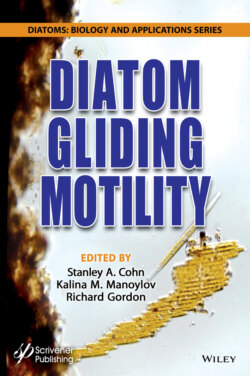Читать книгу Diatom Gliding Motility - Группа авторов - Страница 16
1
Some Observations of Movements of Pennate Diatoms in Cultures and Their Possible Interpretation
ОглавлениеThomas Harbich
Independent Researcher, Am Brüdenrain, Weissach im Tal, Germany
Email: thomas.harbich@diatoms.de Thomas Harbich: https://www.researchgate.net/profile/Thomas_Harbich, https://diatoms.de/en/
Abstract
This chapter presents observations on the motility of pennate diatoms with interpretations and hypotheses. They refer to movement in different environments, on a solid substrate, in a biofilm, on the water surface and in the context of colonies.
The trajectories of certain species on solid substrate are analyzed including the orientation of the apical axis and two hypotheses are made which establish a relationship between motion and the location of the contact point on the diatom to the substrate. The obtained location is validated by observing the movement with a viewing direction parallel to the substrate. Using this method, the author also investigates the change in location of the contact point during reversal of motion. It is furthermore shown that the analysis of the path curvature of certain species allows conclusions to be drawn about the location of the propulsion.
Observations of the movement of Pinnularia viridiformis in and on a biofilm confirm its viscoelasticity. It is shown that elastic deformations of the biofilm, made visible by marking with particles, reveal details of the activity of the raphe branches.
Investigations were carried out on cultivated diatoms which are found on the surface of the water. There, they show movements that partly deviate considerably from the movement patterns on substrate. In Nitzschia sigmoidea, hydrophobicity is assumed to be responsible for buoyancy and its role in structure formation is examined.
Finally, the movement patterns in connection with colony formation in Cymbella lanceolata are studied. Qualitative and quantitative methods are used to show how typical colonies develop on flat substrates due to changing movement activity during the day-night cycle and to the influence of the adhesion force of the gelatinous excretions.
As all observations are based on diatom cultures in a laboratory environment, the possibilities of occurrence of the observed phenomena in nature are discussed in the context of the respective observations.
Keywords: Movements, kinematics, contact point, biofilm, floatability, hydrophobicity, pattern formation, colony formation
